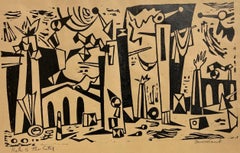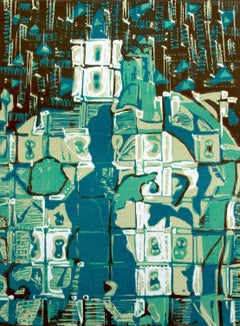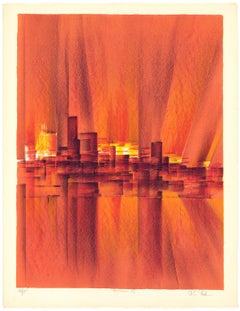Tobias Musicant Prints and Multiples
A new discovery in the art world is something always searched for and rarely found. Surely there was no shortage of artists during the 20th century, but to find someone of immense talent and individuality that has seemingly slipped under the radar of galleries, critics and collectors is rare. An instance where this might occur is when an artist may have been his or her own harshest critic and, for fear of rejection or criticism, such an artist might choose to never show their work in major venues. Somewhere along the way in the promising career of Tobias “Ted” Musicant, his personal insecurity kept his artistic genius from the field of his peers. After participating in numerous prestigious exhibitions early in his career, Musicant became reclusive and kept his art from the public eye. Since the relatively recent death of this artist, a small but powerful body of Modernist paintings has been discovered. These works range in date from 1940 to 1965 and begin in a representational modernist style, evolving into a very interesting and appealing semi-representational hard-edged geometric series that incorporate a flavor of Native American influence. The latest of his paintings are of a surrealist style where the artist includes elements such as birds, fruit, a myriad of unusual objects and architecture into his compositions. His work bears similarities to that of Marsden Hartley, Stuart Davis, Louis Stone and Salvador Dali.
Tobias Musicant was the son of a carpenter and born in Philadelphia in 1921. An artist since childhood, after high school, Musicant attended the Pratt Institute in New York from 1939–41. However, his art studies would be interrupted by World War II as he served his country in the United States Army Air Force, seeing action in England. After the war, Musicant continued his studies at the Art Students League from 1945–48. He lived in Brooklyn in the 1940s and 1950s, eventually moving to Plainsboro, New Jersey, with his sister Alice Musicant, also an artist, where they would both remain throughout their lives. His paintings were exhibited in the Metropolitan Museum of Art in New York, the Pennsylvania Academy of the Fine Arts, the Philadelphia Print Club, the Newark Museum, the Brooklyn Museum, the Butler Institute, and the Princeton Art Council, among other venues. He also had one-man shows at Heffers Gallery in Cambridge, England and the Contemporary Arts Gallery in New York City. In addition to his paintings, Musicant worked in enamels and made silver jewelry.
1940s American Modern Tobias Musicant Prints and Multiples
Linocut
Early 2000s Abstract Tobias Musicant Prints and Multiples
Archival Ink, Archival Paper, Linocut, Archival Pigment
1960s American Modern Tobias Musicant Prints and Multiples
Lithograph
1960s American Modern Tobias Musicant Prints and Multiples
Screen
1960s American Modern Tobias Musicant Prints and Multiples
Lithograph
1970s American Modern Tobias Musicant Prints and Multiples
Lithograph
1920s American Modern Tobias Musicant Prints and Multiples
Etching
1970s American Modern Tobias Musicant Prints and Multiples
Lithograph
Early 20th Century American Modern Tobias Musicant Prints and Multiples
Watercolor
1970s Abstract Geometric Tobias Musicant Prints and Multiples
Paper, Linocut
1960s American Modern Tobias Musicant Prints and Multiples
Black and White, Lithograph
Early 20th Century American Modern Tobias Musicant Prints and Multiples
Etching
Mid-20th Century Expressionist Tobias Musicant Prints and Multiples
Linocut
Tobias Musicant prints and multiples for sale on 1stDibs.
Artists Similar to Tobias Musicant
- What is a music cabinet?1 Answer1stDibs ExpertMarch 22, 2022A music cabinet is a piece of furniture originally used to store sheet music in the 18th century. Most feature solid wood construction and have either drawers or open shelves. On 1stDibs, you can shop a range of antique music cabinets.
- Are music boxes rare?1 Answer1stDibs ExpertApril 5, 2022It depends on the make and model of the music box. To find the value of a music box, experts suggest that you work with a certified appraiser. The value of a music box will depend on a number of factors, including the shape it’s in. You’ll find expertly vetted music boxes on 1stDibs.
- What is the best music box?1 Answer1stDibs ExpertAugust 17, 2021The best music box for you depends on your preferences for design, size, and music. Music boxes may be intricately carved or brightly-colored, and contain musical themes from famous plays or films. Music boxes can also be musical boxes designed to hold jewelry or other trinkets.
- What is a Polyphon music box?1 Answer1stDibs ExpertMarch 22, 2022A Polyphon music box is a wooden box that plays small interchangeable metal discs. Polyphon Musikwerke invented the device in 1870 and began producing them for sale in 1897 in Leipzig, Germany. Find a variety of Polyphon music boxes on 1stDibs.
- 1stDibs ExpertApril 5, 2022The box that plays music is called a music box in the U.S. and a musical box in the UK. Early versions date back to the 19th century, and many of them came from factories located in Switzerland. Shop a large selection of antique and vintage music boxes on 1stDibs.
- 1stDibs ExpertJune 6, 2024Yes, Tobia Scarpa is related to Carlo Scarpa. A well-known architect and designer in his own right, Tobia is the son of the legendary architect Carlo Scarpa. Tobia studied architecture at the Università Iuav di Venezia in Venice, where he met designer Afra Bianchin, who would become his wife and long-time collaborator. On 1stDibs, shop a collection of Tobia Scarpa furniture.
- Are music boxes still made?1 Answer1stDibs ExpertApril 5, 2022Yes, music boxes are still made today. A number of artisans continue to produce music boxes by hand. Companies may also mass produce music boxes using machinery. On 1stDibs, shop a collection of music boxes from some of the world’s top sellers.
- What is an old music box called?1 Answer1stDibs ExpertApril 5, 2022An old music box made from snuff boxes during the 18th century is called a carillons à musique. It is a French word meaning "chimes of music." You'll find a selection of antique music boxes from some of the world’s top sellers on 1stDibs.
- 1stDibs ExpertApril 5, 2022The first music box was likely made in Switzerland around the end of the 18th century. Originally, most music boxes were quite small, but as time went on, larger versions developed. Shop a collection of antique and modern music boxes from some of the world’s top sellers on 1stDibs.
- 1stDibs ExpertAugust 24, 2021Regina music boxes have musical information carefully stored on a metal disc. A Regina music box works when the holes in the disc engage with the teeth of a gear that leads to the plucking of a musical comb generating a pleasant sound.


